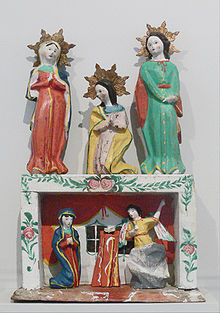Christian customs
Christian customs is the collective term for customs and manners of Christian origin.
features
Customs are - in contrast to individual habits - collective action. It belongs to the sphere of cultic or festive activity and is a sensual form of expression of inner circumstances, religious contexts and ethical norms in the life of the individual and the community. It includes rituals for everyday culture as well as for outstanding events. The liturgy and its rites are not counted as part of custom.
The Joint Synod of the Dioceses in the Federal Republic of Germany (1971–1975) sees "religious customs as signs of God's action and man's response".
Customs have grown and shaped historically, and are therefore predetermined and subject to a certain social control, and thus provide security in social behavior. They are understandable in content and form, in contrast to spell and magic . Customs are changeable and must be able to adapt to changed realities of life. There are elements of the custom that are widespread, while others are regionally limited.
Development of Christian customs
Historically, Christian customs have their roots in the adoption and modification of Jewish customs and, after crossing the national borders of Palestine, religious traditions, ideas and practices of antiquity. While the Christian church was reluctant to adopt pagan customs in the first few centuries, pre-Christian forms became increasingly Christian.
In the Middle Ages, school, guild and class festivals that were based on the church year were occasions for the development of customs, as well as the liturgy itself and the forms of pilgrimage and procession , spiritual drama , veneration of saints and Mary as well as brotherhood .
With the Reformation , a criticism of custom began that led to a “desensitization” of the Christian festival year. In the Catholic Church from the end of the 18th century a revision of emotional popular piety was initiated through preaching and catechesis with the aim of acquiring theological knowledge.
In the 19th and 20th centuries, both denominations became aware of the value of an enlightened custom, which was researched as "religious folklore ". Customs also arose in the Protestant area. The Advent wreath z. B. was introduced in 1839 by the Evangelical Lutheran theologian and educator Johann Hinrich Wichern .
The situation in the present is ambivalent. History, tradition and custom are rejected, while elsewhere growing interest in religious customs, meaning and form can be observed in the search for one's own identity. In some customs, the knowledge of the religious origin has almost been lost, such as Carnival or Halloween .
Areas of Christian customs
Some customs were formed around feasts and the administration of sacraments . The expressions of the liturgical celebration themselves are not considered to be customs.
Basic Christian customs:
- Prayer : morning prayer , evening prayer , grace prayer
- Blessing : Eucharistic blessing , weather blessing , floor blessing
- Cross : crucifix , devotion to the cross , sign of the cross
- Incense , bells
In the course of life:
- Baptism : baptismal water , baptismal robe
- Confirmation or confirmation
- Birthday , name day , wedding day
- Wedding : blessing of the rings
- Primiz
- Death customs , burial culture : funeral service , cemetery , funeral feast , death pictures , wake , death pictures , funeral prayer , seven footfalls
During a church year :
- Advent : Advent calendar , Advent wreath , Nicholas , hostel search , Rorate
- Christmas : Christmas tree , Christkind , Fatschenkind , crib , crib laying , Paradeisl (paradise tree)
- New Year's Eve
- Epiphany : carol singing
- Carnival / Mardi Gras / Carnival : Carnival Monday , Rose Sunday
- Lent
- Holy Week : Palm Sunday , palm branch , palm donkey , Maundy Thursday , Mount of Olives hour , Mount of Olives play , Good Friday , Passion story , Passion play , Triduum Sacrum
- Easter : Easter egg , Easter fire , Easter bunny , Easter candle , Easter lamb , Easter water , Easter fountain , Easter laugh , food blessing
- Ascension Day : Prayer days , Ösch procession
- Pentecost
- Corpus Christi
- Thanksgiving festival , parish fair
- All Souls' Day : All Souls Drain

Catholic customs:
- Eternal adoration , devotion to the Sacred Heart of Jesus , processions , worship of relics , rosary , guardian angel , devotional objects
- Maria : Thirty women , herb consecration , May devotion
- Adoration of saints : Barbarazweig , Bartholomäustag , Blasiussegen , Florian , Georgiritt , Leonhardifahrt , Luciafest , Martinstag , Valentinstag
- Brotherhoods : Good Death Brotherhoods, Rosary Brotherhood , Scapular Brotherhood
- Pilgrimage , supplication processions , votive pictures , votive offering
- Wayside shrine , Marterl , Benedictine blessing , Arma-Christi-Kreuz
- House altar , Herrgottswinkel , holy water container , Agatha label
- Mezzotint
Orthodox customs:
In the community:
See also
Individual evidence
- ^ Resolution "Divine service": 6.1.4 Sacramentals and customs
- ↑ Manfred Becker-Huberti : Celebrations, festivals, seasons. Living customs throughout the year , Freiburg (Breisgau) 1998, ISBN 3-451-27702-6 , pp. 16–24
- ^ Manfred Becker-Huberti, celebrations, festivals, seasons. Living customs throughout the year , Freiburg (Breisgau) 1998, ISBN 3-451-27702-6 , pp. 21–24
literature
- Manfred Becker-Huberti: Celebrations - Festivals - Seasons. Living customs all year round . Herder, Freiburg-Basel-Vienna 1998, ISBN 3-451-27702-6 .
- Herman Kirchhoff: Christian Customs. Festivals and customs in the annual cycle . Kösel, Munich 2004, ISBN 3-466-36663-1
- Alfred Läpple: Small Lexicon of Christian Customs . Pattloch, Augsburg 1996, ISBN 3-629-00679-5 .
- Dietz-Rüdiger Moser : Customs and festivals in the Christian course of the year. Customs of the present in cultural-historical contexts . Edition Kaleidoskop from Verlag Styria, Graz 1993, ISBN 3-222-12069-2 .
Web links
- folklore europaea / Festivals - Customs - Traditions in Europe (folklore multimedia database)


